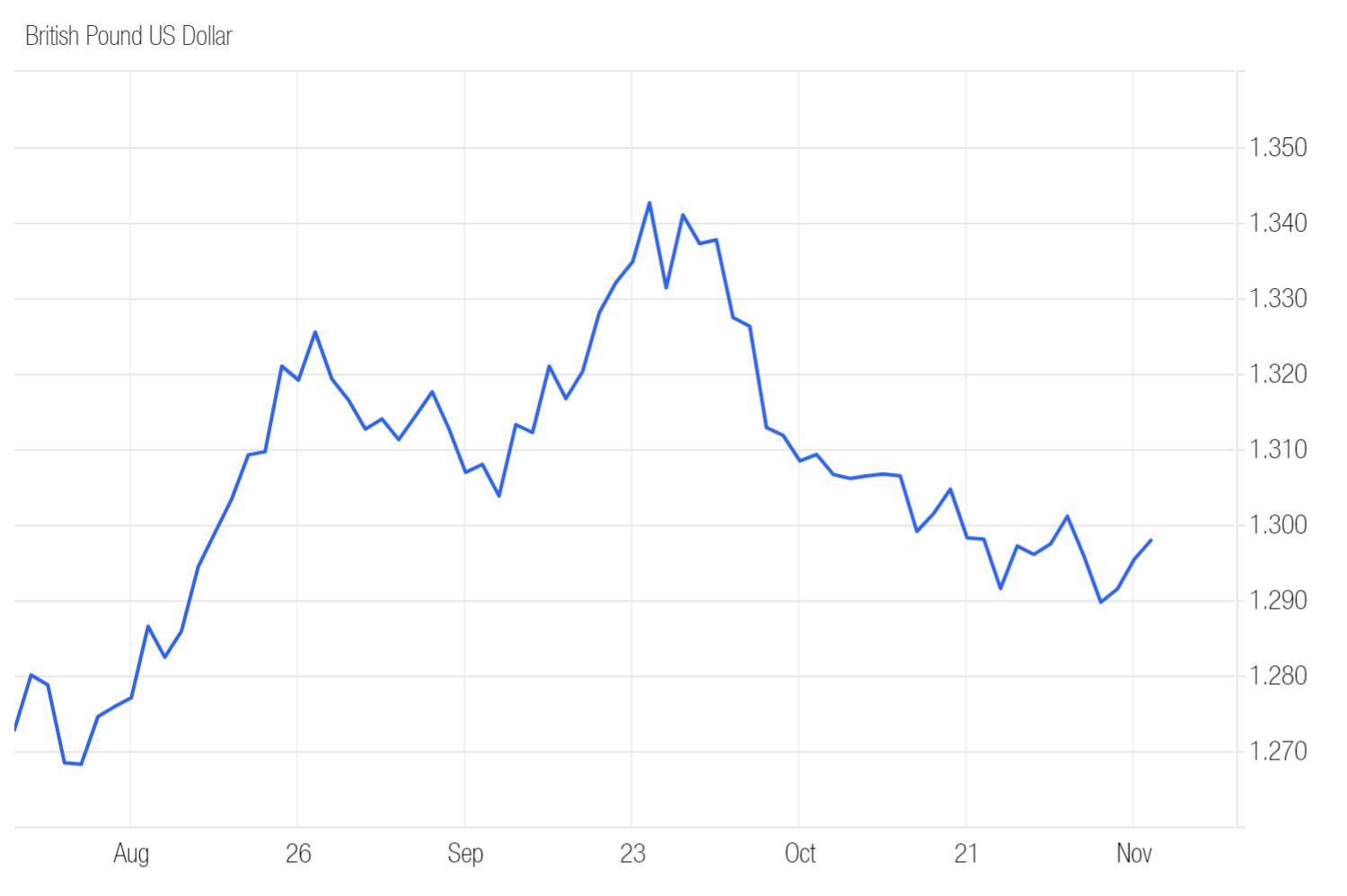GBP/USD exchange rate touches two-month low in October following UK budget
The pound dollar exchange rate slipped to an eight-day low in the $1.32 mid-range after the escalating conflict in the Middle East flustered markets. This prompted widespread risk aversion, attracting investors to the safe-haven dollar.
The pair slumped to a two-week low around $1.311 on 3 October following comments from Bank of England (BoE) Governor Andrew Bailey. Speaking on the future path of UK interest rates, the central bank chief explained that the BoE may have to be ‘more activist’ regarding future cuts.
The pound extended its losses the following day, falling to fresh multi-week lows below $1.31 after the latest US non-farm payrolls report exceeded forecasts. In September the US economy recorded the strongest jobs growth in six months and above the monthly average for the past year. This led investors to scale back bets on another 50bps interest rate cut from the Federal Reserve, boosting the dollar.
The pound briefly touched a fresh three-week low versus the dollar on 7 October amid Middle East market jitters that prompted investors to favour the safe-haven dollar.
Having drifted into the $1.30 mid-range, the pound dollar rate was buoyed by a positive UK GDP print on 11 October. The reading showed that the UK economy expanded 0.2% in August, as forecast, after two months of zero growth.
The pound dollar rate was muted following the publication of a mixed jobs report from the UK economy on 15 October. The unemployment rate printed below forecast in August, falling from 4.1% to 4%, rather than remaining static as expected, marking the lowest level of unemployment in the UK since the start of the year. However, average earnings (excluding bonuses) fell to the lowest level in over two years, reigniting BoE interest rate cut bets for November which limited the pound’s upside.
The pair sunk just below the $1.30 benchmark the next day, touching an eight-week low, following the publication of the UK’s latest Consumer Price Index (CPI), which reported UK inflation plummeted from 2.2% to 1.7% in September – the weakest print since April 2021 and below the drop to 1.9% forecast by economists. With headline inflation firmly below the BoE’s 2% target, investors ramped up bets that the central bank will deliver back-to-back interest rate cuts in November and December, undermining the pound.
The pound’s recovery was thwarted by upbeat US retail sales data on 17 October that showed sales growth printed at 0.4% in September, up from 0.1% and above the expected reading of 0.3%. This boosted the dollar, derailing the pound’s upward momentum.
The pound dollar rate rallied above the $1.30 level on 18 October after the release of above-forecast UK retail sales data that dampened fears around the UK’s slowing economy. While the 0.3% growth reported in September was a slowdown from August’s 1%, it was far better than the 0.3% contraction forecast by economists.
The pair slid to a two-month low in the $1.29 mi-range on 22 October on the back of UK budget jitters and US political uncertainty. News of the third-highest September on record for UK public borrowing compounded concerns that the Autumn Budget would deliver a painful combination of tax rises and spending cuts. Meanwhile, rising market odds for a Donald Trump victory in the US presidential election on 5 November lifted the dollar amid expectations of fewer Fed interest rate cuts.
The pound hit a fresh two-month low on 23 October, around $1.294, amid a risk-averse market mood that boosted the safe-haven dollar, together with Trump trade.
The pound had firmed to within touching distance of the $1.30 benchmark by 28 October amid a torrent of tailwinds: hopes that the UK Autumn Budget will boost investment, downbeat US data, and an improving market mood.
The pound dollar rate wavered on 30 October after Rachel Reeves delivered the new Labour government’s first budget in 15 years. UK Chancellor announced a raft of expected tax rises that caused the pound to fall around 0.5% into the $1.29 mid-range.
Investor’s sanguine reaction to the budget evaporated the following day, forcing the pound to drop sharply against the dollar into the $1.28 mid-range – a fresh two-month low.
GBPUSD: 3-Month Chart

Looking ahead
The BoE kept interest rates on hold at 5% in September, but a further cut is expected following its next policy meeting on 7 November amid cooling UK inflation – a move that is likely to apply downward pressure to the pound.
Influential data from the UK economy in November: ILO Unemployment Rate (12 November), Average Earnings Excluding Bonus (12 November), GDP (15 November), Consumer Price Index (20 November), Retail Sales (22 November), S&P Global/CIPS Services PMI (22 November).
A Trump victory in the US presidential election and Republican control of Congress could support the dollar in November, while a blue sweep would likely undermine the US currency. However, the most probable scenario of a divided government could limit volatility.
Market participants are almost fully pricing in an interest rate cut at the Fed’s 7 November policy meeting, which could cushion the dollar’s downside should Kamala Harris triumph.
Influential data from the US economy in November: Nonfarm Payrolls (1 November), ISM Manufacturing PMI (1 November), ISM Services PMI (5 November), Michigan Consumer Sentiment Index (8 November), Consumer Price Index (13 November), Producer Price Index ex Food & Energy (14 November), Retail Sales (15 November), S&P Global Services PMI (21 November), GDP (27 November).






